The Aigle-class destroyers (“contre-torpilleurs”) were built for the French navy in 1931-34. Very similar to the previous Guepard class, they still had an improved machinery with higher pressure boilers for an extra 0.5 knots (0.93 km/h; 0.58 mph) in top speed plus the new 138 mm gun type using a sliding breech block for a higher rate of fire. The class, unlike the previous one, adopted marine and birds of prey names. There is a parallel by the way with the German 1923 and 1924 torpedo boats, at the time built as destroyers, the “raubtier” and “raubvogel” which did exactly the same. Their fate was as absurd as the rest of French destroyers, four were scuttled in Toulon in November 1942 while the others were sunk during Operation Torch in Oran and Casablanca by allied ships. Two were raised and repaired postwar, seeing more service in the 1950s.

Milan in 1936-37
Development
The Aigle class were an extrapolation of the Jaguar class, and close to the Guepard class, larger and with four funnels. They were part in a long serie of “super-destroyers”, very fast and heavily armed, typical of the Marine Nationale in 1939. They were purely a product of their time, the 1920s, when the Regia Marina was the most probable enemy, and the fleet was divided into two types of escorts, the “torpilleurs” or standard light destroyers, stuck escorting troopships and fleet vessels, and on the other hand the “contre-torpilleurs” which role was to go and catch any destroyer opponents, by being faster and better armed, protecting the fleet or convoy in a more proactive way, keeping the threat away and neutralizing it before to could come close to do harm. As usual, given their aggressive roles, they were given names of birds of prey, like the previous ships were named after “big cats”.
The class comprised six ships, built into two groups, called “C” and “D”: The first comprised Aigle (A C de France, Dunkerque) laid down in 1928, Gerfaut (A C de Bretagne) in 1929, Albatros (A C de la Loire) in 1929 and Vautour (F C de la Méditerranée) in 1929. Average construction time was 3 years.
“D” group comprised Épervier (Arsenal de Lorient) laid down in 1930 and Milan at the same yard and time, completed both in May 1934. The latter were different from the first groups, modernized and modified in several ways (see later). They prepared the venue for the next Vauquelin class, the last “4 tuyau”.
However, despite this large size they were in 1940 deficient in many ways. No strong anti-air defence, weak torpedo armament for their size, slow-firing main guns with primitive fire controls, indigent ASW armament, old-style hydrophones and no radars for their entire wartime carer.
Design of the class
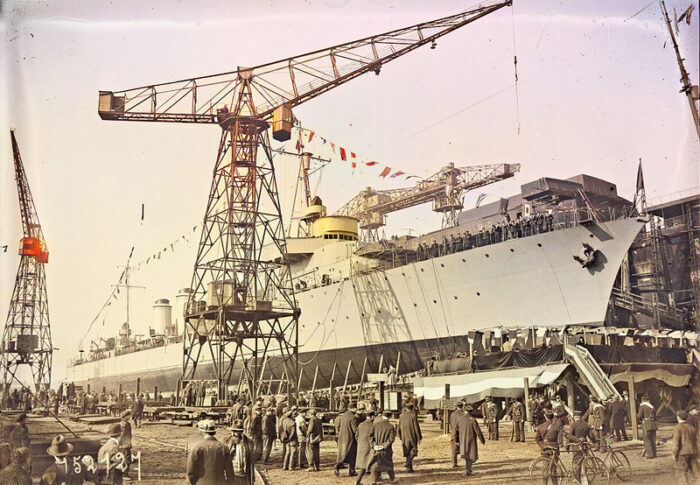
Hull and general design
The Aigle were very close to the Guepard class in many ways, the general design was about the same, as their typical silhouette with four funnels. The proportions of the forecastle, typical poop with internal depth charge chutes, the way the main armament was placed in old-fashioned superfiring positions. The bridge was modelled the same way as before, as the fire control installation and tripod masts of different size fore and aft. They had the same greyhound style that made them fearsome on movies of the time. The prow had the same clipper style, the forecastle had flare, and the single rudder was the same as before, as the shaft struts. The peculiar prow was not only design to clear out depht charges after they were dropped, they also better protected the rudder from plunging fire.
However, there were concerns about improving agility and stability for this class, and engineers decided to shorten them, while increasing the beam: They measured as completed 128.5 m (421 ft 7 in) overall for a beam of 11.8 m (38 ft 9 in) and draught of 4.97 m (16 ft 4 in), versus 130.2 x 11.5 m x 4.68 m. Displacement was lighter at 2,441 long tons (2,480 t) standard and 3,140 t (3,090 long tons) fully loaded, versus 2,436 metric tons (2,398 long tons) standard, 3,220 metric tons (3,170 long tons) for the previous Guepard. The next Vauquelin will keep this beam but returned to a bit longer hull, and even greater draft, for a slightly higher displacement, compensated by better machinery. They were unofficially dubbed the “2400 tonnes” in the French Navy.
The Aigle class had a metacentric height of 0.8 m (2 ft 7 in). Their crew amounted to 10 officers and 198 crewmen in peacetime, 10 officers and 217 enlisted men in wartime, for which they had two cutters and many rafts.
Protection
Just like previous destroyers, it was limited to non-armoured measures, so heavy compartmentation of the powerplant spaces, with full separation of the steam turbines, one tasked for powering a shaft each, separated by transverse bulkheads, as were the four boilers in line (each exhausting in its own funnel). The hull was divided indeed by a dozen transverse bulkheads into 13 watertight compartments (12 for the Guepards). There were also light longitudinal bulkheads along the powerplant spaces, so about 1/3 of the hull. There was a double hull running for 80% of the hull. One reasoning behind the single boiler’s funnel instead of truncated exhaust was resilience. Shortening exhaust, id not having long truncation sensible to hits, decreased the risk of loosing steam pressure if the exhaust lines were ruptured or destroyed. Here, each exhaust was directly above its own funnel.
Later it was discovered there were backsides to this solution as well, so the next Vauquelin class ended as the last “four pipers” in the French Navy, and the next Fantasque and Mogador had two funnels with truncations.
Powerplant
The Aigle class repeated the powerplant of the previous Guepard essentially. They were powered by two geared steam turbines driving each a single fixed-pitch bronze 3-bladed propeller, on a strutted shaft. Steam was provided by four du Temple boilers operating at a pressure of 20 kg/cm2 (1,961 kPa; 284 psi) and temperature of 215 °C (419 °F). This was considered low for the time, so work was done to improve this and new boilers were provided for the last two ships (see below). The turbines were rated for 64,000 metric horsepower (47,000 kW; 63,000 shp) enough for a contracted top speed of 36 knots (67 km/h; 41 mph).
In the end, they exceeded their designed speed with ease, with the fastest, Gerfaut, reaching an astonishing 41.46 knots (76.78 km/h; 47.71 mph) from 84,436 PS (62,103 kW; 83,281 shp) on sea trials. The problem however was the same as in the Regia Marina, and mostly these numbers were for propaganda, the ships did these trials in unrealistic conditions, perfectly calm seas and weather, no ammunition, food, water or full crew on board, just enough fuel for the trials. In these conditions, the draught was reduced, so less hull mass to punch through water as well. The contract speed of 36 knots was more a combat condition top speed, provided the weather was still mild. However in heavy weather, they had the advantage of their exceptionally long hull for destroyers, and could more easily cut the waves instead of riding them, thus maintaining speed to around 30 knots.
The Aigle class carried 540 t (530 long tons) of fuel oil for a range of 3,650 nautical miles (6,760 km; 4,200 mi) at 18 knots (33 km/h; 21 mph). This was less than the previous Guepards (572 t fuel oil, 3,000 nm at 14.5 knots) but it seems they were more economical.
The steam system of the last two ship of the Aigle class, Milan and Epervier, consisted of four superheated steam boilers rated at 27 kg/cm² instead of 20 kg/cm². They were also slightly more powerful at 68,000 hp instead of 64,000 hp. Except the superheated steam boilers, these new arrangements were adopted on the six Vauquelin ships, which shared the same design.
Armament
The Aigle class sported five 138.6 mm (5.5 in) Modèle 1927 guns as main armament, all in the axis, under single shielded mounts Their anti-aircraft armament was beefier than for previous ships, with four 37 mm (1.5 in) Modèle 1927 guns single mounts all amidships. However, shortages meant Gerfaut and Albatros were completed instead with the old 75 mm (3 in) M1897-15 gun forward of the rear funnels, replaced by the end of 1932. All had two triple 550-millimeter (21.7 in) torpedo tubes banks. The main guns were directed by the same old-fashioned stereoscopic concidence telemeter installed on the bridge and aft.
Other and more visible differences of the last two, Milan and Epervier were their seven torpedo tubes, with one triple axial platform and two double ones, one on each side (instead of two triple axial banks). Their searchlights were also relocated from the bridge to forward of the third funnel.
138.6 mm (5.5 in)/40 M1927 guns

One superfiring pair fore and aft of the superstructure and the fifth gun abaft the rear funnel. They were no longer the M1923, but the M1927.
The latter was designed to be faster-firing, albeit the range was inferior to the M1923. The Canon de 138 mm Modèle 1927 was indeed derived from a German World War I design and adopted for the Aigle, Vauquelin classes DDs, Bougainville-class sloops. Overall, they were faster guns with a firing cycle of 4 or 5 seconds thanks to their automatic spring rammer, but this was broken by their antiquated dredger hoists transporting shells and cartridge cases, so they ended at 8-10 rounds per minute practical, which was even worse than for the M1923 of the previous class.
specifications 138.6mm/40 M1927:
Weight: 4,100 kg (9,000 lb)
Barrel length: 5.544 m (18 ft 2.3 in)
Elevation/Traverse -10/+28 degrees, 300°
Loading system: semi-automatic spring rammer, horizontal sliding-block
Muzzle velocity: 700 m/s (2,300 ft/s)
Range: 28 degrees: 16,600 m (18,200 yd) SAP
Guidance: Optical + FCS
Crew: 7-8
Round: 130x900mm R Separate-loading, cased charge
Rate of Fire: 8-10 rounds/minute
75 mm AA
These WWI AA guns were only fitted two ships in class, and removed after a short time in 1932 as seen above.
37 mm AA
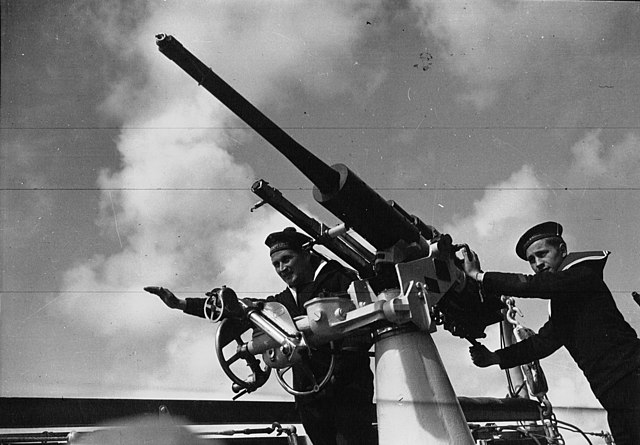
The Modèle 1925 was a single gun mount, hand-loaded, semi-automatic, with a low rate of fire compared to their clip-fed models, and fired a low projectile weight with a low velocity. All this combined to have only four of them make for a poor AA defence, even if that was a pair more than the previous Guepard.
specifications 37mm/50 M1925:
Weight 661 lbs. (300 kg)
Barrel length 79.0 in (2.007 m), Bore 72.8 in (1.850 m)
Elevation/Traverse -15/+80 degrees, 360°
Loading system Welin breech Block
Muzzle velocity 2,657 fps (810 mps)
Range 7,850 yards (7,175 m) a 45°
Guidance Optical + FCS
Crew 3
Round 6.2 lbs. (2.8 kg) full HE Model 1925 1.6 lbs. (0.725 kg), Incendiary.
Rate of Fire 30-42 (15-21 practical)
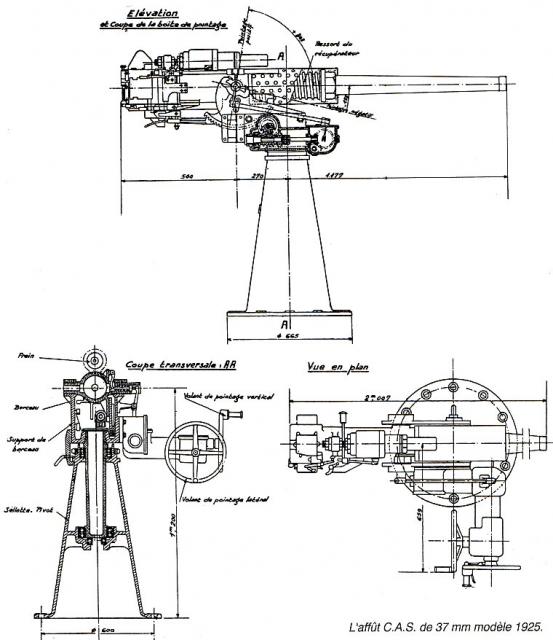
13.2 mm AA
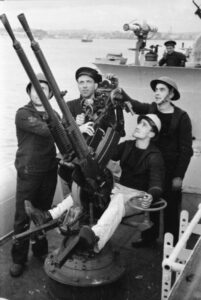 Two pairs of these were installed before the war. These twin 13.2 mm/75 heavy machine guns were later expanded to two more mounts, notably one forward of the bridge. This was a high rate of fire system on a light mount designed by Le Prieur. The 13.2mm was a Gas-operated system fed by 30-round box magazine, or 15-round feed strips. It was copied by Japan and Italy and used by the axis in WW2. The round was peculiar in this it was a 12.7 × 99 mm Browning (.50 BMG) cartridge necked up to 13.2 mm caliber. A short round (96 mm) was introduced in 1935. It ws mostly adopted for fixing the barrel wear issue. Hotchkiss developed also single and quad mounts, one which was studied by the US.
Two pairs of these were installed before the war. These twin 13.2 mm/75 heavy machine guns were later expanded to two more mounts, notably one forward of the bridge. This was a high rate of fire system on a light mount designed by Le Prieur. The 13.2mm was a Gas-operated system fed by 30-round box magazine, or 15-round feed strips. It was copied by Japan and Italy and used by the axis in WW2. The round was peculiar in this it was a 12.7 × 99 mm Browning (.50 BMG) cartridge necked up to 13.2 mm caliber. A short round (96 mm) was introduced in 1935. It ws mostly adopted for fixing the barrel wear issue. Hotchkiss developed also single and quad mounts, one which was studied by the US.
⚙ specifications 13.2mm M1929 HMG
Mass 37.5 kg (83 lbs) per gun stripped.
Length: 1.67 m (5 ft 6 in), Barrel 1 m (3 ft 3 in)
Shell: 13.2×99mm Hotchkiss Long (1929).
Elevation -10° to +90°, traverse 360°, 450 rpm cyclic, 200-250 rpm sustained
Muzzle velocity: 800 m/s (2,625 ft/s)
Max range: 7.2 km (4.5 mi), Effective 4,200 m (13,800 ft)/45°
Torpedo Tubes
Like the previous class, they had two axial torpedo tubes banks. There was one mount between the two pairs of funnels, as well as another aft of the rear funnel. These were of the same model as the previous class. It seems strange that at this point the French did look at developing a quad torpedo tubes bank, that would provide more firepower more in line with their great size. I cannot found a reason but for stability concerns and lack of incentive for the manufacturer of these mounts to develop such arrangement. The last two had instead two twin banks forward, on either broadside, to compensate somewhat. Contemporary US destroyer managed to have triple and even later quad TT banks on the broadsides.
23D/DT 550mm TORPEDOES:
The 23DT was for destroyer leaders (Contre-Torpilleurs).
Weight: 4,560 lbs. (2,068 kg), for 27 ft. 2 in. (8.280 m) x 500 mm (21.7 inches).
Warhead: 683 lbs. (310 kg) TNT
Powered by a Schneider alcohol fed air heater, 4-cyl.
Speed settings: 9,840 yards/39 kts or 14,200 yards (13,000m)/35 kts.
ASW armament
They had a pair of depth charge chutes built into their stern with a well containing eight each or a total of sixteen 200-kilogram (440 lb) depth charges, eight more in reserve. They also fitted had four depth-charge throwers, two on each broadside, abreast the forward funnels, with a dozen 100-kilogram (220 lb) depth charges in reserve. The location was quite unusual and the provision was low.
Guiraud Model 1922: Weight 573 lbs. (260 kg) for a 441 lbs. (200 kg) charge for 50 x 88 cm (19.7 x 34.6 in).
Sink Rate or terminal velocity 10 fps (3 meters per sec.) with 100, 165, 250 and 330 feet (30, 50, 75 and 100 m) settings, later augmented to 120m.
For the Thornycroft Y-Guns, Guiraud Mle 1922 100-kilogram (220 lb) depth charges.
The Aigle class had no proper sonar, but the same hydrophones carried by the previous classes. Only Panthère was fitted with a passive Walser acoustic locator. The upgrade was cancelled due to budget cuts. Some were fitted with the British Type 123 ASDIC system in 1939–40.

Author’s old illu
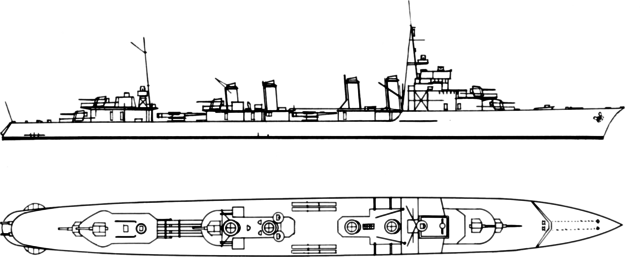
Profile CC

Author’s profiles of the Aigle class
⚙ Aigle class specs. |
|
| Displacement | 2,441 t standard, 3,140 t full load |
| Dimensions | 128.5 x 11.8 x 4.4 m (421 ft 7 in x 38 ft 9 in x 14 ft 5 in) |
| Propulsion | 2 shafts GST, 4x du Temple boilers 64,000 PS (47,000 kW; 63,000 shp) |
| Speed | 36 knots (67 km/h; 41 mph) |
| Range | 3,650 nmi (6,760 km; 4,200 mi) at 18 knots (33 km/h; 21 mph) |
| Armament | 5× 138.6 mm, 1x 75 mm, 4× 37 mm AA, 2×3 550 mm TTs, 2 DCR (16), 4 DCT (12) |
| Sensors | Hydrophones, Radars (1942) |
| Crew | 10 officers, 217 crewmen (wartime) |
Career of the Aigle class
 Aigle (5, 6 and X13)
Aigle (5, 6 and X13)
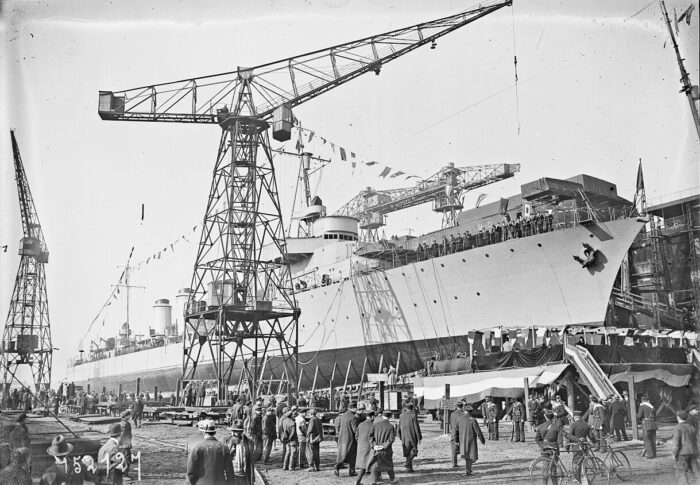
The launch of Aigle in 1931
“Eagle” was laid down at Ateliers et Chantiers de France, Dunkirk, Launched 19 February 1931, completed on 10 October 1932. On her sea trials, she managed to reach 38,66 kts.
During World War II, Aigle was repeatedly engaged in gold bullion transport operations. In November 1939, she escorted ships Force Z (Lorraine+ two La Galissonnière-class cruisers) to the Atlantic. In March-April 1940, she provided escort for Force X, detached often to escort troop convoys, from North African ports to Marseille. Her last mission was a participation in th raid on Genoa on the night of June 13-14, 1940: Operation Vado. She repelled an Italian torpedo boats attack. No more records found so far. In research.
She was scuttled on 27 November 1942, Refloated 10 July 1943 by the Italians but never repaired, bombed and sunk by the allies on 24 November 1943, broken up in situ 1952.
 Vautour (6, 5, 73, X71)
Vautour (6, 5, 73, X71)
(no CC photo)
“Vulture” was Built by Forges et Chantiers de la Méditerranée, La Seyne, launched on 26 August 1930, Completed 2 May 1932. She entered service on March 15, 1932, with a crew of 217 under command of Louis Collinet. From January 15, 1931, to March 14, 1932, she underwent refitting. When the war broke out, she was stationed in Toulon, operating in the Mediterranean as escort for the 7th Destroyer Division (7eDCT). She was placed in dry dock by late 1939 and early 1940 for upgrades. Next she was stationed in Brest and Cherbourg, still as escort, but mechanical problems reduced her activity.
On 18 April 1940 Vautour departed Brest in escort of Convoy FP 2, en route Greenock, Scotland and arrived on 20 April.
In early June 1940, she reached Toulon, when the Armistice took her by surprise. She joined the Vichy Navy, was placed under the authority of Admiral Jean de Laborde, part of 37 ships, the High Seas Forces. She rarely went out due to the scarcity of fuel and ammunition.
No more records found so far. In research.
She was also scuttled in Toulon on 27 November 1942 in Missiessy dock, refloated on 17 January 1943 by the Italians, never repaired, bombed and sunk by the allies on 4 February 1944, broken up in situ 1951.
 Albatros (3, 2, 5, 72, X73, X77, F762, D614)
Albatros (3, 2, 5, 72, X73, X77, F762, D614)
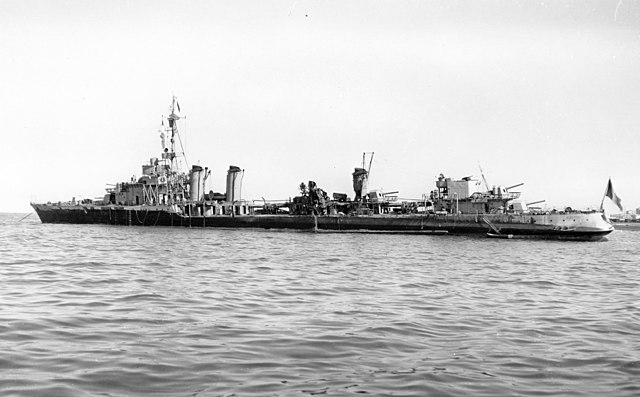
Albatros in Casablanca, laying grounded, post Casablanca battle
Albatros was built by Ateliers et Chantiers de la Loire, Nantes, launched on 27 June 1930, completed 25 December 1931. On 14 June 1940 she took part in Operation Vado, on Genoa and Savona and damaged by the coastal battery “Mameli” with a 152 mm (6 in) round. No more records found so far. In research.
With Vichy France, she was present at the battle of Casablanca in November 1942, badly damaged by the heavy cruisers USS Augusta, USS Wichita, and USS Tuscaloosa, bombed by aircraft from USS Suwanee, beached in a sinking condition. After the war she was repaired and returned to service until decommissioned on 9 September 1959.

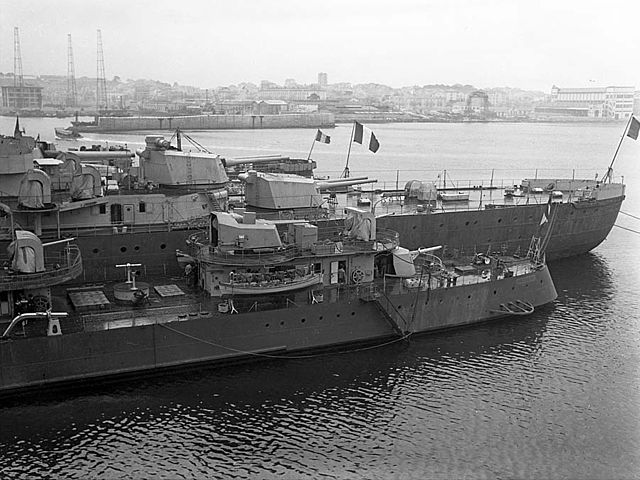
 Gerfaut (4, 71, X72)
Gerfaut (4, 71, X72)
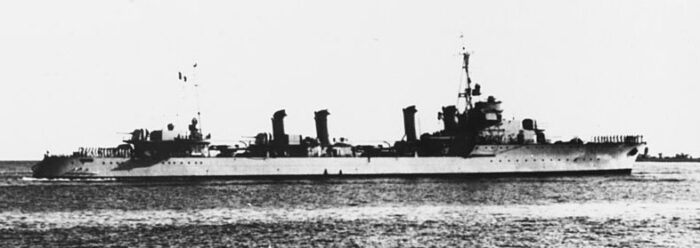
“Gyrfalcon” was built by Ateliers et Chantiers de Bretagne, Nantes, launched on 14 June 1930, completed on 30 January 1932.
No records found so far. In research.
Scuttled on 27 November 1942 in Toulon. Refloated by the Italians on 1 June 194, partly scrapped in June–September 1943 and her hulk bombed and sunk on 7 March 1944, broken up in situ 1948.
 Milan (1, 4, X113, X111)
Milan (1, 4, X113, X111)

“Kite” was built by Arsenal de Lorient, Launched on 13 October 1931, Completed 20 April 1934. On 7 December 1939 she was part of a task force reinforced by the aircraft carrier HMS Hermes, also made of the heavy cruisers Foch, Dupleix; light cruiser HMS Neptune and destroyers Milan (under Commander M.A.H. Favier) and Cassard (Cdr. Braxmeyer). They departed Dakar for patrol in the mid-Atlantic, later joined by HMS Hardy, HMS Hero and HMS Hostile. They were back at Dakar on 16 December.
On 29 December HMS Hermes flew off some of her aircraft off Dakar, escorted by Cassard. Later with Foch, Dupleix, Milan and Cassard they departed Dakar for France. HMS Hermes was detached to join convoy SLF 14.
On 12 April 1940 she was in the 11e Division de Contre-Torpilleurs (D.C.T.) under command of Capitaine de Fregate L. M. E. Plumejeaud. She departed Brest in escort of Convoy FP 1 A to Greenock, Scotland. She was en route rammed on her starboard side by the British trawler Glamorgan Coast on 13 April, resulting in a vertical gash in her hull. She was under repairs from 16 to 18 April after arriving at Greenock on 14 April.
Following the German invasion of Norway she thus escorted two convoys transporting French Chasseurs Alpins troops to Namsos and Harstad on 18 April and 27 April. From 3 to 4 May 1940, she patrolled the Skagerrak alongside the French destroyers Chevalier Paul and Tartu and British destroyers Sikh and Tartar.
On 5 May 1940 she was detached to escort troopships departing Scapa Flow: The French armed merchant cruisers El D’Jezair, El Kantara, El Mansour, French troopships Djenne, President Doumer, and British troopships Duchess of Atholl, Reina del Pacifico. They were escorted to the Clyde, made the passage with HMS Suffolk. The escort outside Milan comprised HMS Kelly, Grenade, Griffin, Imperial and the French Chevalier Paul and Tartu. They arrived in the Clyde the next day.
On 13 May she was sent to escort Convoy NP 3, departing the Clyde on 13 May 1940 for Narvik, arrived on 17 May 1940 with the Polish troopships Batory and Sobieski. Outside Milan the escort comprised HMS Delight and Antelope. They arrived on 17 May.
On 15 June 1940, she transported General de Gaulle from Brest to Plymouth on the first leg of his voyage to London for talks with the British government.
No more records found so far. In research.
On 8 November 1942, off Casablanca, she was hit by the destroyer USS Wilkes and finished off by 16-inch shells from the US fleet’s Task Force 34, and had to be beached at the battle of Casablanca. She was never repaired and scrapped in situ.
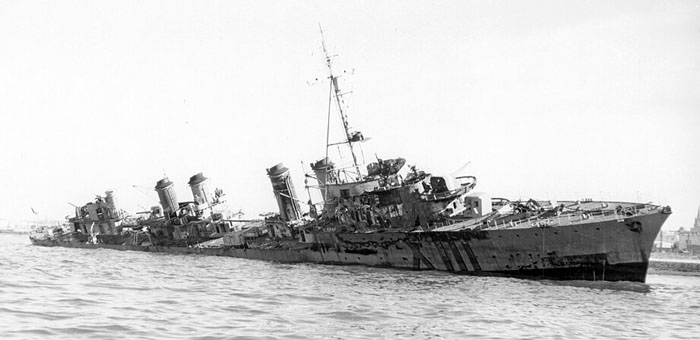
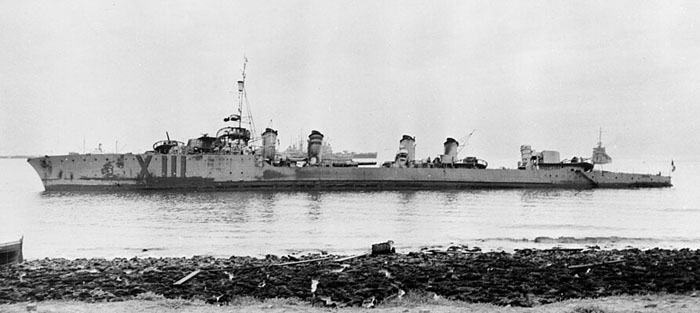
 Épervier (2, 5, X112)
Épervier (2, 5, X112)
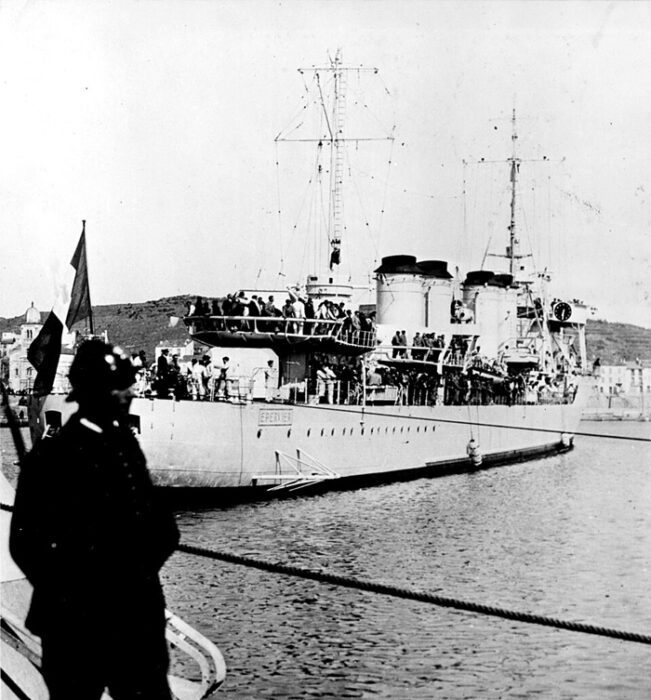
“Sparrowhawk” was built by Arsenal de Lorient, launched on 14 August 1931, completed on 1 April 1934. Epervier under Capitaine de Fregate J. J. G. Bros was part of the 11e Division de Contre-Torpilleurs (Capitaine de Vaisseau Jean Adolphe Roger Bouan) in 1939. They departed Brest in escort of Convoy FP 1 A, en route to Greenock, Scotland. They arrived on 14 April.
No more records found so far. In research.
On 9 November 1942 she was sunk by HMS Aurora off Oran (Battle of Oran, North Africa, Operation Torch, British sector). She was engaged by the British light cruiser HMS Aurora. Badly damaged, she had to be beached to prevent her from sinking. The severity of the damage after inspection led to her to be stricken as a total loss. The wreck was sold in 1949 to Société Maroc Métaux. She was towed from Oran to Casablanca in September 1949. The hull of the Épervier was dismantled in Casablanca in early 1951 after being raised in 1946.
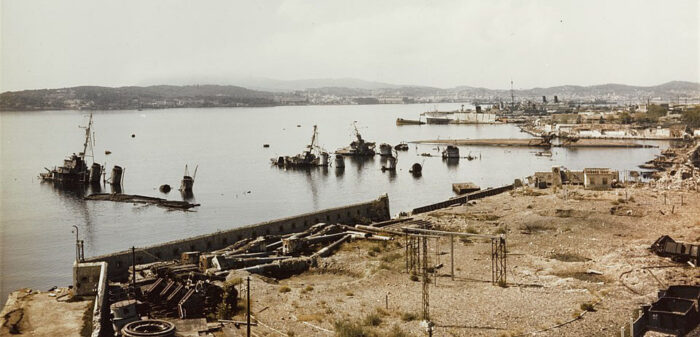

Read More/Src
Books
Cernuschi, Enrico & O’Hara, Vincent P. (2013). “Toulon: The Self-Destruction and Salvage of the French Fleet”. In Jordan, John (ed.). Warship 2013.
Chesneau, Roger, ed. (1980). Conway’s All the World’s Fighting Ships 1922–1946. Greenwich, UK: Conway Maritime Press.
Jordan, John & Moulin, Jean (2015). French Destroyers: Torpilleurs d’Escadre & Contre-Torpilleurs 1922–1956. Barnsley, UK: Seaforth Publishing.
Rohwer, Jürgen (2005). Chronology of the War at Sea 1939–1945: The Naval History of World War Two (Third Revised ed.). NIP
Whitley, M. J. (1988). Destroyers of World War Two: An International Encyclopedia. NIP
Jean Lassaque, Les contre-torpilleurs Épervier et Milan, 1931-1946, Marines Éditions, France, 1996, 95 pages.
Henri Darrieus et Jean Quéguiner, Histoire de la Marine française (1922-1942), éditions L’Ancre de Marine, 1996
Henry Le Masson, Histoire du torpilleur en France, édition Académie de marine, 1967.
Henri Darrieus et Jean Quéguiner, Histoire de la Marine française (1922-1942), page 29
Collection “Mémoire et citoyenneté”, N °1, Publication Ministère de la défense/SGA/DMPA, « La campagne de Norvège (9 avril – 7 juin 1940), cheminsdememoire.gouv.fr
Pierre Montagnon, La France dans la guerre de 39-45, Paris, Pygmalion, mai 2009, 938 p.
Links
alabordache.fr/ aigle-ct/
alabordache.fr/ vautour-ct/
alabordache.fr/ epervier-ct/
alabordache.fr/ albatros-ct/
alabordache.fr/ gerfaut-ct/
alabordache.fr milan-ct/
uboat.net/ navy=FR
web.archive.org navypedia.org/ aigle.htm
fr.wikipedia.org Classe_Aigle
en.wikipedia.org Aigle-class_destroyer
commons.wikimedia.org/
forummarine.forumactif.com/
Gallery
Model Kits
HP-Models | No. WW II-WL-F-008 | 1:700

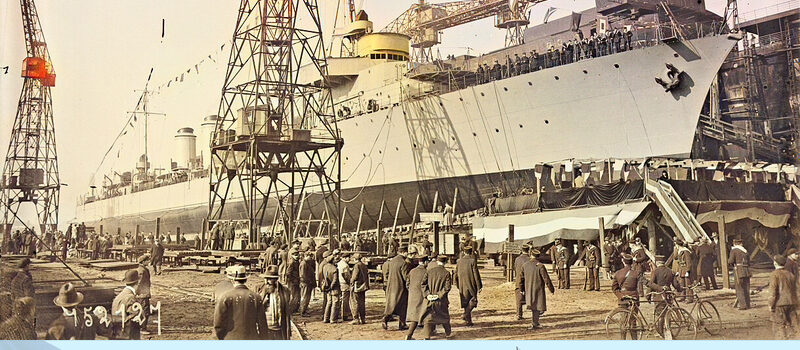

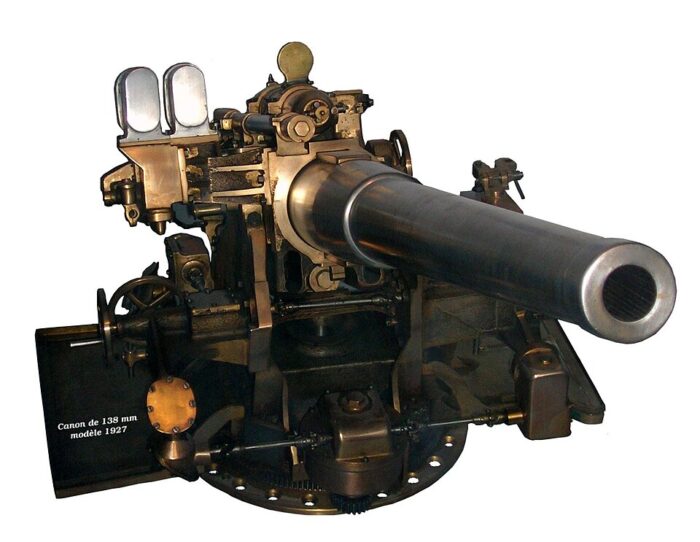








 Latest Facebook Entry -
Latest Facebook Entry -  X(Tweeter) Naval Encyclopedia's deck archive
X(Tweeter) Naval Encyclopedia's deck archive Instagram (@navalencyc)
Instagram (@navalencyc)

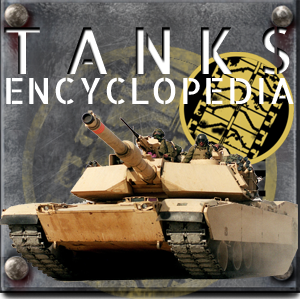
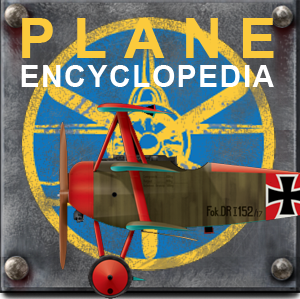
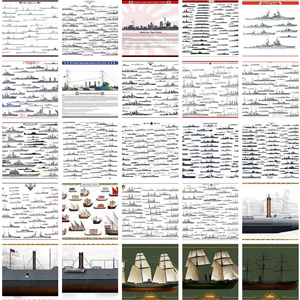
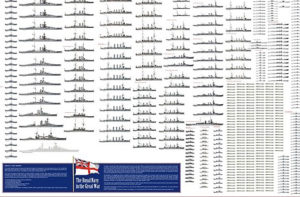
 French Navy
French Navy Royal Navy
Royal Navy Russian Navy
Russian Navy Armada Espanola
Armada Espanola Austrian Navy
Austrian Navy K.u.K. Kriegsmarine
K.u.K. Kriegsmarine Dansk Marine
Dansk Marine Nautiko Hellenon
Nautiko Hellenon Koninklije Marine 1870
Koninklije Marine 1870 Marinha do Brasil
Marinha do Brasil Osmanlı Donanması
Osmanlı Donanması Marina Do Peru
Marina Do Peru Marinha do Portugal
Marinha do Portugal Regia Marina 1870
Regia Marina 1870 Nihhon Kaigun 1870
Nihhon Kaigun 1870 Preußische Marine 1870
Preußische Marine 1870 Russkiy Flot 1870
Russkiy Flot 1870 Svenska marinen
Svenska marinen Søværnet
Søværnet Union Navy
Union Navy Confederate Navy
Confederate Navy Armada de Argentina
Armada de Argentina Imperial Chinese Navy
Imperial Chinese Navy Marinha do Portugal
Marinha do Portugal Mexico
Mexico Kaiserliche Marine
Kaiserliche Marine 1898 US Navy
1898 US Navy Sovietskiy Flot
Sovietskiy Flot Royal Canadian Navy
Royal Canadian Navy Royal Australian Navy
Royal Australian Navy RNZN Fleet
RNZN Fleet Chinese Navy 1937
Chinese Navy 1937 Kriegsmarine
Kriegsmarine Chilean Navy
Chilean Navy Danish Navy
Danish Navy Finnish Navy
Finnish Navy Hellenic Navy
Hellenic Navy Polish Navy
Polish Navy Romanian Navy
Romanian Navy Turkish Navy
Turkish Navy Royal Yugoslav Navy
Royal Yugoslav Navy Royal Thai Navy
Royal Thai Navy Minor Navies
Minor Navies Albania
Albania Austria
Austria Belgium
Belgium Columbia
Columbia Costa Rica
Costa Rica Cuba
Cuba Czechoslovakia
Czechoslovakia Dominican Republic
Dominican Republic Haiti
Haiti Hungary
Hungary Honduras
Honduras Estonia
Estonia Iceland
Iceland Eire
Eire Equador
Equador Iran
Iran Iraq
Iraq Latvia
Latvia Liberia
Liberia Lithuania
Lithuania Mandchukuo
Mandchukuo Morocco
Morocco Nicaragua
Nicaragua Persia
Persia San Salvador
San Salvador Sarawak
Sarawak Uruguay
Uruguay Venezuela
Venezuela Zanzibar
Zanzibar Warsaw Pact Navies
Warsaw Pact Navies Bulgaria
Bulgaria Hungary
Hungary

 Bundesmarine
Bundesmarine Dutch Navy
Dutch Navy Hellenic Navy
Hellenic Navy Marina Militare
Marina Militare Yugoslav Navy
Yugoslav Navy Chinese Navy
Chinese Navy Indian Navy
Indian Navy Indonesian Navy
Indonesian Navy JMSDF
JMSDF North Korean Navy
North Korean Navy Pakistani Navy
Pakistani Navy Philippines Navy
Philippines Navy ROKN
ROKN Rep. of Singapore Navy
Rep. of Singapore Navy Taiwanese Navy
Taiwanese Navy IDF Navy
IDF Navy Saudi Navy
Saudi Navy Royal New Zealand Navy
Royal New Zealand Navy Egyptian Navy
Egyptian Navy South African Navy
South African Navy






























 Ukrainian Navy
Ukrainian Navy dbodesign
dbodesign